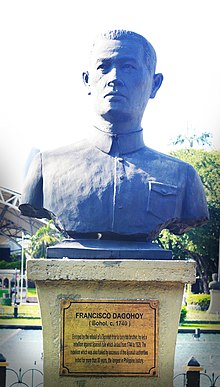Francisco Dagohoy
| Francisco Dagohoy | |
|---|---|
 The bust of Francisco Dagohoy at the Rizal Park in Manila | |
| Kamundagan | Francisco Sendrijas c. 1724 Inabanga, Bohol, Captaincy General of the Philippines |
| Kagadanan | Talibon, Bohol, Captaincy General of the Philippines |
| Organisasyon | Boholano insurgents |
Si Francisco Dagohoy, (pinangaki na Francisco Sendrijas kan 1724) sarong Filipinong rebolusyunaryo na igwang pinakahalabang pag-aklas sa kasaysayan kan Filipinas, an Rebelyong Dagohoy. An rebelyon na ini laban sa pananakop sa gobyerno nin Espanyol na nangyari sa isla nin Bohol puon 1744 hanggang 1828,[1] mga haros 85 na taon. Nagpuon si Francisco Dagohoy nin pag-aklas sa edad na 20. Tintantiyang nagadan siya kan1829 sa kagurangan o pagkakahelang.[2]
Legasiya
[baguhon | baguhon an source]
Si Dagohoyan minimidbid na pasimuno nin pag-aaklas base sa talaan sa kasaysayan sa Filipinas. Ini nasa 85 na taon (1744–1828).[1]
An siyudad na kun saen dinakulaan ni Dagohoy na Bohol pinangaranan para sa saiyang onra. An dating presidente na si Carlos P. Garcia (na nagin Bise Presidente), sarong Boholano, an nagpanukala nin ngaran.
Nota
[baguhon | baguhon an source]Mga toltolan
[baguhon | baguhon an source]- ↑ 1.0 1.1 Zaide 1957.
- ↑ Palafox, Quennie Ann J. (September 6, 2012). "THE VISION OF FRANCISCO DAGOHOY". nhcp.gov.ph. National Historical Commission of the Philippines. Archived from the original on May 3, 2021. Retrieved September 14, 2020.
- ↑ Bohol-Philippines.com 2008.
Ginikanan
[baguhon | baguhon an source]- Bohol Chronicle, Jes Tirol (4 Hunyo 2006). "Abatan River Cruise: A travel through history". Archived from the original on September 28, 2007. https://archive.today/20070928003433/http://www.theboholchronicle.com/opinion.php?issue=158&s1=2100&s2=2105&s3=2114&s4=%09%09%09%09%09%09%09&s5=2112&s6=603&s7=2113&s9=. Retrieved on May 3, 2021.
- Bohol-Philippines.com (16 Enero 2008). "Francisco Dagohoy: A Slice of History and Myth". Archived from the original on January 16, 2008. Unknown parameter
|url-status=ignored (help); Check date values in:|date=(help) - Hellingman, Jeroen (4 Abril 2002). "A Short History of Bohol (Part I)". IJsselstein. Archived from the original on June 1, 2002. Unknown parameter
|url-status=ignored (help); Check date values in:|date=(help) - Hellingman, Jeroen (5 Oktubre 2003). "Bohol, Cave Country". IJsselstein. Archived from the original on May 26, 2004. Unknown parameter
|url-status=ignored (help); Check date values in:|date=(help) - Constantino, Renato; Constantino, Letizia R. (1975). The Philippines: A Past Revisited. Tala Publishing Series. ISBN 9789718958001.
- Zaide, Gregorio F (1957). Philippine Political and Cultural History. I. Philippine Education Company. ASIN B008Q24O10.
Panluwas na takod
[baguhon | baguhon an source]- Abeto, Isidro Escare (1989). "XXXIV The Longest Fight for Reform". Philippine history : reassessed. The United States and its Territories 1870–1925: The Age of Imperialism. Manila: Integrated Publishing House. pp. 167–169.
- Artigas y Cueva, Manuel (1916). Historia de Filipinas para uso de los alumnos del Instituto Burgos y de otros colegios particulares: pro Manuel Artigas y Cuerva. Manila: La Pilarica. p. 192.
- Blair, Emma Helen; Robertson, James Alexander, eds. (1907). The Philippine Islands, 1493–1898. Volume 48 of 55 (1751–1765). Historical introduction and additional notes by Edward Gaylord BOURNE. Cleveland, Ohio: Arthur H. Clark Company. ISBN 978-1103521159.
Explorations by early navigators, descriptions of the islands and their peoples, their history and records of the catholic missions, as related in contemporaneous books and manuscripts, showing the political, economic, commercial and religious conditions of those islands from their earliest relations with European nations to the close of the nineteenth century.
- Corpuz, O. D. (2007). The Roots of the Filipino Nation. Vol. 1. University of Hawaii Press. ISBN 978-9715424608.
